The use of a low-energy bulb contributes to the protection of the environment. It also reduces consumption by 10 times and saves 20% on electricity bills. But with several models available on the market, it is difficult to choose one. This guide will help you find the right model for you.
Here is our commitment, to make sure that we provide the best user experience and content quality:
You can support us by using our links to make your purchases (at no extra cost to you)! This sometimes earns us a commission which allows us to remain independent. More about us
Our selection
"These 10 G4 Tailcas LED bulbs will create a warm and bright atmosphere with pleasant brightness. In addition, they do not produce any humming or…"
"Enjoy a higher luminous efficiency than other energy saving bulbs with these 2 x 10W LED bulbs from Expertline. You will love their white color."
"Very bright, these Sansi low-energy bulbs have a cool white color and a 270° beam angle for a light temperature of 4000 lumens."
"The Philips FluoCompact energy saving bulb is very popular with French households. Not surprising when you know that it saves up to 80% of energy…"

These 10 G4 Tailcas LED bulbs will create a warm and bright atmosphere with pleasant brightness. In addition, they do not produce any humming or flickering.
10,38 £ on AmazonTailcas G4 LED bulbs are manufactured according to European energy saving standards. They are ideal for replacing old halogen lamps and can emit the equivalent light of a normal 20W halogen capsule. In addition, these low-energy bulbs are inexpensive and use only 1.5 W of electricity. Their lifespan of 20,000 hours accentuates this energy saving.
Unlike halogen bulbs, Tailcas bulbs emit a much cleaner light. Their color never varies and does not fade. With this set of 10 bulbs, you will save up to 90% on your electricity bill. Moreover, they are very easy to install, you will not need the help of an electrician. So, you know what you have to do to light your home differently.
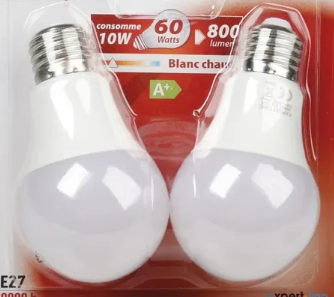
Enjoy a higher luminous efficiency than other energy saving bulbs with these 2 x 10W LED bulbs from Expertline. You will love their white color.
4,80 £ on CdiscountExpertline offers us these 2 bulbs with a luminous flux of 800 lumens, with a unit power of 10 W. These low energy bulbs each have a lifespan of 20,000 hours, 10 times longer than conventional incandescent lamps. Thanks to the all-purpose look, you can use them in a wide variety of rooms, especially those where compact and efficient lamps are needed. Note the good light quality and instant start time.
Beyond the price, the brightness is the big advantage of this set of 2 Expertline bulbs. Indeed, each bulb proposed in this set has a power of 10 W, but the brightness is equivalent to that of a 60 W warm white bulb, not to mention the light temperature equivalent to 3000 kelvins. In addition, these LED bulbs can replace halogen and incandescent lamps in an environmentally friendly way.
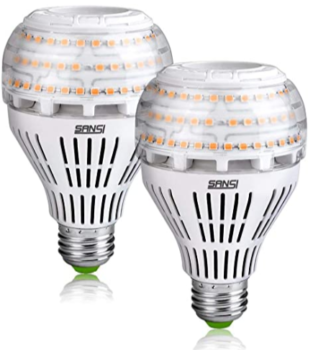
Very bright, these Sansi low-energy bulbs have a cool white color and a 270° beam angle for a light temperature of 4000 lumens.
25,59 £ on AmazonLight up your home or office space with low energy bulbs. These are 27W E27 LED screw-in bulbs. Each one emits 4,000 lumens of bright light equivalent to a 250W incandescent bulb, all with a cool white tint! With a life of up to 25,000 hours, they provide consistent lighting performance with no drop-off over time. Also note the 270° beam angle.
Versatile, the 2 Sansi low-energy bulbs are perfect for the kitchen, bedroom or living room. In addition, they offer over 80 bright color effects, making them excellent indoor lighting for hobbies, photography and more. Finally, they save up to 90% of electricity. However, you will have to pay the price.

The Philips FluoCompact energy saving bulb is very popular with French households. Not surprising when you know that it saves up to 80% of energy and lasts 10 years.
8,39 £ on AmazonAny specific needs?
The best low-energy light bulb in 2021
The best entry-level low-energy light bulb
The best high-end low-energy light bulb
A great spiral low-energy light bulb
Your guide :
Rate this buying guide :By rating this buying guide, you are helping us to reward our best writers. Thank you!
| TOP OF THE TOP | CHEAP | EXCELLENT | EXCELLENT | |

In accordance with our commitment, this buying guide does not contain any sponsored products. |
 9/10 |
 8/10 |
 9/10 |
 8/10 |
| OUR SELECTION |
Pack of 10 LED G4 Tailcas Bulbs
|
Set of 2 LED bulbs E27 10 W Expertline
|
Set of 2 low-energy bulbs Cold White Sansi
|
Ampoule Philips FluoCompacte 23 W
|
|
These 10 G4 Tailcas LED bulbs will create a warm and bright atmosphere with pleasant brightness. In addition, they do not produce any humming or flickering.
|
Enjoy a higher luminous efficiency than other energy saving bulbs with these 2 x 10W LED bulbs from Expertline. You will love their white color.
|
Very bright, these Sansi low-energy bulbs have a cool white color and a 270° beam angle for a light temperature of 4000 lumens.
|
The Philips FluoCompact energy saving bulb is very popular with French households. Not surprising when you know that it saves up to 80% of energy and lasts 10 years.
|
|
|
Number of bulbs supplied
|
10
|
2
|
2
|
1
|
|
Cap type
|
G4
|
E27
|
E27
|
E27
|
|
Wattage
|
1.5 W
|
10 W
|
27 W
|
23 W
|
|
Color temperature
|
3,000 kelvin
|
3,000 kelvins
|
6500 kelvins
|
6,500 kelvins
|
|
Life span
|
20,000 h
|
20,000 h
|
25 000 h
|
10 years
|
Help us improve this table:
Report an error, request the addition of a feature to the table, or suggest another product. Thank you for your kindness!
We spend thousands of hours each year studying the major specialized websites, analyzing products of hundreds of brands and reading user feedback to advise you on the best products.
We are a product review company with a single mission: to simplify your buying decisions. Our research and testing helps millions of people every year find the best products for their personal needs and budget.
To support us you can: use our links to make your purchases (which often earns us a small commission), share our articles on social networks, or recommend our site on your blog. Thanks in advance for your support!
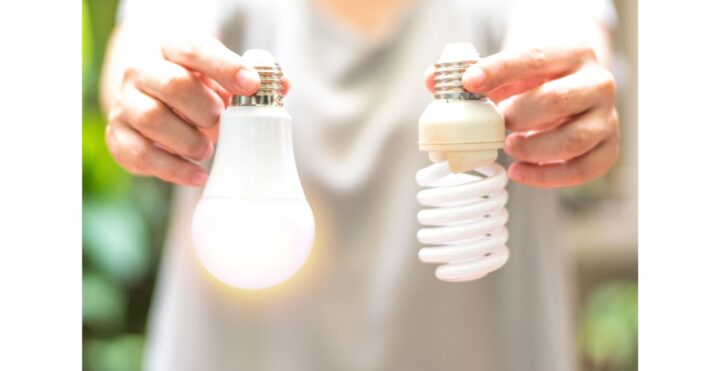
The main characteristics to consider when choosing a low-energy light bulb are: the shape, the type of base and the energy efficiency.
-The shape: you can choose a stick, globe, reflector, flame and many others. The shape of the bulb defines the visual comfort. It also allows you to better define the lighting effects you want. For example, a spotlight bulb is best suited to concentrate light rays in a single point.
-The type of base: it is essential to choose the right type of base of bulb as well as its size to ensure the compatibility with a luminaire. There are two main types of bulb bases: pin base and screw base. A pin base is presented under the letter G, followed by a number that expresses the distance in millimeters between the two pins. It is also presented under the letter GU if it is composed of two pins that allow the bulb to be fixed by making a quarter turn in the grooves of the socket.
-Energy efficiency: in terms of energy savings, the performance of a bulb informed on the label is rated from A +++ to D. The better the rating, the better the energy savings.
The level of brightness is expressed in watts and lumens. Watts describe the power consumption of the bulb. While, lumens measure the luminous flux produced. The more lumens a bulb produces, the brighter the light. Because of this, when you choose a low-energy bulb, it's looking at lumens rather than watts.
Known by the acronym IRC, color rendering describes how well a light source makes the color of an object appear to the human eye. Following a scale of 0 to 100, CRI also indicates the color rendering of a "given" light source compared to a "reference" light source. However, light sources with a CRI between 85 and 90 have a good color rendering. On the other hand, if you need to determine the colors more precisely, light sources with a CRI from 90 are excellent.
The voltage of the electric charges that circulate in the low-energy bulb is expressed in volts (V). Generally, it works with an electrical voltage of 12 or 24 V, so it is lower, compared to other types of bulbs that work on 230 V.
It is important to specify that a low voltage bulb does not mean that it is low consumption. For maximum efficiency, the voltage of the bulb should match the power supply voltage of your appliance. However, keep in mind that a low voltage consumes more current and a high voltage may reduce the life of your low voltage bulb.
Even if the types of low-energy light bulbs do not have the same lifespan, the means to extend their lifespan will be generalized. Indeed, it is possible that their duration is shorter or longer than what is mentioned on their packaging. In order to make your bulbs last longer, apply the following methods.
Avoid moving hot bulbs
It is more than obvious that moving hot bulbs can reduce their life span. Indeed, a heated bulb is much more fragile and may break easily. This is not only due to its, but also to its location. A low-energy bulb installed in a place that moves like the ceiling fan or the slamming of a refrigerator door can affect its lifespan. That's why other low-energy bulbs are marketed as "ceiling fan bulbs" or "appliance bulbs".
Leave your light bulb on longer
This may sound contradictory, but it is not, as many research and experiments have proven. Every time you flip the switch, you are giving energy to your light bulb. Its temperature can change in a fraction of a second, the cathodes of fluorescent tubes are subjected to 600 V every time you flip the switch. If you do this too often, the low-wattage bulb will easily fail.
Run your low-wattage bulb
When you reduce the intensity of a low-wattage bulb, you reduce the voltage supplied, which puts less stress on it. This principle applies especially to a fluorescent bulb. An LED bulb that is already programmed to turn on instantly provides a much lower starting voltage and heat to a bulb. Running a low power bulb at low voltage will extend the life by more than 30%.
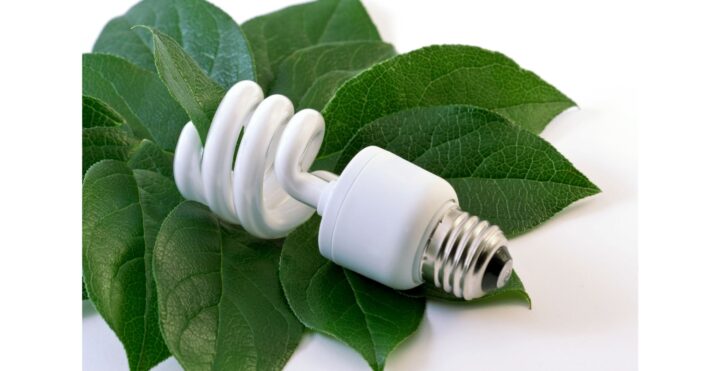
These are the most economical types of bulbs. They come in several models such as the white or yellow light model, the quick start model.
Advantages:
Disadvantages:
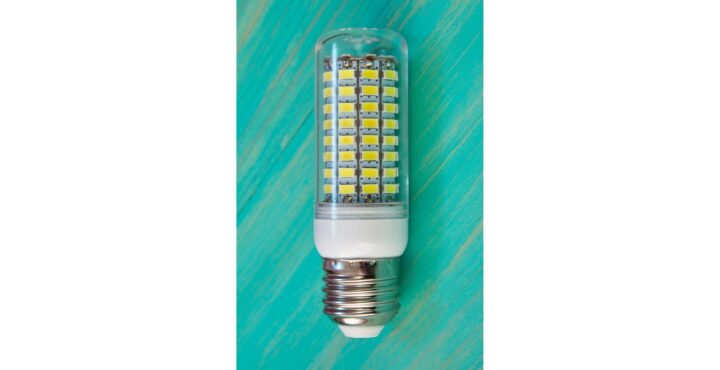
The LED bulbs
Among the 3 types of low energy bulbs, LEDs are the most advantageous. They have a beautiful lighting quality, longer life than other bulbs.
Advantages:
Disadvantages :

We all know that the old halogen bulbs are energy consuming. But we are talking about the low-energy halogen bulbs which have less qualities than the compact fluorescent and LED, but more efficient than the incandescent bulbs.
Advantages:
Disadvantages :
A fluorescent or compact fluorescent bulb consists of a fluorescent tube wound 3 times or more with a base that includes an electronic ballast. Intended for a domestic use, this type of bulb has a white or cold color. Its particularity is that it lasts up to 10 years or more, with an ignition time of 1 second. Moreover, it consumes four times less electricity than a simple incandescent bulb. But it has some disadvantages: its electronic system does not support the humidity nor the very high heats, and its components (fluorescent powders, mercury) are dangerous for the environment.
This type of bulb is the most commonly used in French households. A LED light bulb is composed of a semiconductor chip and it works with a movement of electrons that gives off light. One of the main reasons why many consumers choose LED bulbs is its bluish-white color rendering and instant on time. In addition to that, LEDs are much more environmentally friendly due to its low energy consumption and can last up to 15 years. But even though LED bulbs consume less electricity, their manufacturing process is still energy consuming. In addition, this type of bulb does not yet support high power lighting.
In fact, there is no such thing as a low-energy bulb of poor quality. You can choose any model according to your taste. You just have to know if their specificities correspond to the results you are looking for. For a good general lighting, a fluorescent bulb will perfectly meet your expectations. If you want good energy efficiency, an LED bulb will be much more suitable.
Clean your low-energy bulb regularly.
Regular cleaning optimizes the energy efficiency of a bulb. To do this, simply use a clean, dry microfiber cloth.
Use a dimmer switch to make a low-energy bulb less bright.
The use of a dimmer switch is recommended to darken your low-energy bulb, if necessary. That way, you can always adjust the brightness. A dimmer for a low-energy bulb is to be installed in place of the light switch or plugged into an outlet.
Avoid putting too much voltage on your bulbs so they don't burn out.
An average voltage in a house is between 220 to 230 volts, to make sure you don't exceed 230 volts, a check by an electrician is necessary.
Idetect a burned-out low-energy bulb easily.
To find out if a bulb is burned out, you just need to use a multimeter on its terminals and put it in the "test diode" position. If it displays values, the bulb is still working. If it doesn't, it doesn't show anything; it means your bulb is no longer working.
The following simple actions can help you keep your low-energy bulb.
The first obvious reason is that it reduces the electricity bill. Secondly, its use saves a lot of energy in general, if all consumers use it. And the last more important reason is that a low energy bulb is very much involved in environmental protection.
LED bulbs consume the least amount of energy and they also have an unmatched lifespan. In addition, this type of bulb saves energy and is environmentally friendly, as it does not contain mercury or lead. LEDs also work much better than other types of energy-saving bulbs, if you use a dimmer switch.
For a household with 25 light sources in general. The daily lighting counts about 7 h, or 2,464 h for a year. So a household consumes an average of 450 kWh to 729 kWh to light up for a year.
You can easily recognize a low-energy bulb. Read the energy efficiency on its label carefully. Most of them display a class A or B efficiency. The B means that its quality is lower, but it is more efficient than a conventional incandescent bulb.
Every month we help more than 1 000 000 people buy better and smarter.
Copyright © 2022 - Made with ♥ by buyingbetter.co.uk
Your reviews and buying guides 0% advertising, 100% independent!